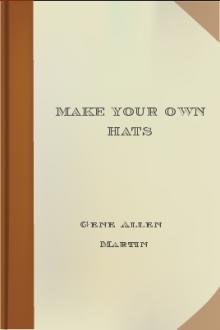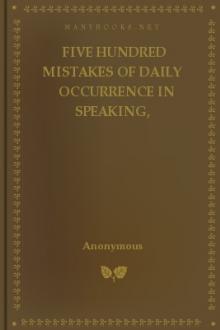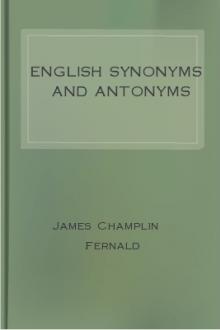Make Your Own Hats, Gene Allen Martin [ebook offline txt] 📗

- Author: Gene Allen Martin
- Performer: -
Book online «Make Your Own Hats, Gene Allen Martin [ebook offline txt] 📗». Author Gene Allen Martin
Willow plate—
A coarse straw-like material, light in weight, brittle, and very expensive, used in blocking; frames are also made from it without blocking.
Must be dampened before using. Not recommended for amateurs.
Wire comes in black, white, silver, and gilt, and is covered with cotton, mercerized cotton, and silk. It may be procured in single and double bolts.
Cable—
Largest wire used in millinery. In making wire frames, it is used as edge wire and sometimes for the entire frame. Being larger than frame wire, it makes a pleasing effect when used as part of the wire frame design, if it is to be covered with sheer material.
Frame or brace wire—
Used in making frames and is sewed on the edge of all buckram and fabric hat frames.
Lace—
Smaller than frame wire, used for wiring lace ribbon and flowers, and sometimes for making an entire frame when a very dainty design is desired.
Tie—
Smallest wire used in millinery; comes wound on spools. Is used to tie other wires, and in making hand-made flowers. Comes in black, white, and green.
Ribbon—
A cotton ribbon about three eighths of an inch wide, with a fine wire woven through the center, also a wire on each edge. Used to wire ribbons.
Sprung—
An uncovered steel wire used to make halo brims; is sometimes sewed on edge of buckram or other fabric brims, if the hat is unusually wide, or if a brim is to be especially stiff. It is occasionally used as an edge wire on wire frames.
Hat Frames of Fabric
Much care, thought, and patience must be exercised in making the frame of any hat. It is the foundation upon which we build, and if poorly made no amount of work can cover it up later. A hat must be right every step of the way. The frame is the first step, and so the most important.
The simplest hat to make is the straight brim sailor with a square crown, covered with velvet. Such a model we will take up at first.
Sailor hat frame—
For convenience we will use the following dimensions: Width of brim, three inches; height of crown, three and one-half inches; length of crown tip, eight and one-half inches; width of crown tip, six and one-half inches, and headsize, twenty-four inches.
Pattern for brim—
Cut from a piece of manila paper fourteen and one-half by fourteen and one-half inches the largest possible circle; the paper may be folded into halves, then quarters, then into eighths and creased.
A round brim will not be of equal width all around from headsize wire, because the headsize wire must be oval to fit the head. The front and back will both be about an inch narrower than the sides.
Headsize wire—
To measure—This is especially important, for upon the accuracy of this measurement depends the comfort of the wearer; this is the foundation wire. Pass a tape measure around the head over the hair where the hat is to rest and add two inches to this measure. One is for lapping the ends and the other inch is to allow for lining and covering of hat which goes up into the headsize.7-1
As our headsize measure is twenty-four inches long, cut a piece of frame wire twenty-six inches long; this allows for the two inches just mentioned. Lap the ends one inch and fasten each end with tie wire.7-2 Wire always laps one inch—no more, no less.
To shape—With the hands inside, pull the circle until it is elongated to fit the head. This headsize wire must not press unduly upon any part of the head.
To locate headsize on pattern—Lay pattern flat, pin headsize wire on pattern with joining at back crease in paper, having the back and front of brim of equal width, and the two sides of brim of equal width. Mark all around headsize wire with a pencil. Remove wire and cut paper one-half inch inside this mark.
To cut buckram brim—Lay pattern on smooth side of buckram, pin, and cut the edges very smoothly. Cut headsize same as pattern. Mark location of center back and center front. Remove pattern and with a hot iron press the buckram perfectly flat, being careful not to break or make a sharp bend in the buckram, for if once broken it cannot be satisfactorily repaired.
To sew headsize wire to brim—First note the relation of headsize wire to brim. If buckram is carefully cut, the wire may be pinned on one-half inch from edge. The brim has been cut round and will have the appearance of a round hat when worn and yet, on account of the oval headsize wire, the brim when finished will measure about three and one-half inches on each side and about two and one-half inches back and front. Pin wire on smooth side of buckram with lap at center back, also pin front and each side, being careful not to lose the shape of the headsize wire. Bring needle up from under side of brim close to wire, beginning at lap. Take stitch over wire to under side coming back through first stitch to right side. Take next stitch over wire one-fourth inch from first, coming back to right side. Repeat all the way around until lap is reached. Fasten thread by taking several stitches close together over ends of wire in order to join neatly and prevent their working loose. Slash buckram inside headsize wire every half inch and turn pieces up. This makes small flaps to which crown may be fastened later. The brim may now be tried on and changes made if necessary.
Edge wire—
This is cut from frame wire and must be long enough to reach around edge of brim and lap one inch. Edge wire is always sewed on same side of brim as the headsize wire, which is usually the smooth side. Shape this wire to conform to shape of brim. Never depend on the hat or the stitches to hold a wire in place. Begin at center-back of hat holding wire toward you, and sewing from right to left. Hold wire as near the edge as possible, without letting it slip over the edge. Sew on with overcasting stitch, taking two stitches in same hole. Take the stitches just the depth of the wire. If too shallow, the wire will slip off over the edge, or, if too deep, the wire will slip back away from the edge leaving it unprotected and liable to become broken and uneven-looking. A frame must be well made in every detail to produce satisfactory results when finished.
To cover edge wire—All edge wire must be covered with crinoline or a cheap muslin. Cut a strip of such goods on a true bias, three-eighths of an inch wide. Remove the selvage and stretch the strip. Bind the edge wire with it, holding it very tight. Sew close to wire using a stab stitch.
Right side—wrong side—
This stitch is made by taking a long stitch on right side and then a short back stitch on wrong side. Lap ends of crinoline one-fourth inch at finish, but do not turn ends under.
Square crown—
A square crown is one having a flat top, or one only slightly rounded, with the sides slightly sloping in towards the top. A crown of this type three or three and one-half inches in height would be at least one and one-half inches smaller at the top than at the bottom. Any crown made separately from the brim must be large enough to cover the headsize wire on the brim at the base. To eliminate any slashes or seams in the side crown, a paper pattern should be made. Following paragraphs explain how this is done.
Pattern for slanting side crown—
Cut a piece of manila paper one-fourth inch wider than crown height and one-half inch longer than headsize wire measure. Slash across this paper in four equally distant places, within one-fourth inch of edge of bottom, then lap slashes at top a little more than one-fourth inch, or about enough to take out about one and one-half inches. Pin slashes. Lap ends of paper one-fourth inch and pin together. Place this pattern on brim with joining at back and pin to upturned slashes on brim. Try on to see if any alterations are necessary. It can be decided at this point and changes made should the crown be too sloping or too straight. An amateur should try on a frame often in order to be assured of lines and curves that are becoming. Remove pattern from brim and cut off from top and bottom any irregularities on the edge.
To cut side crown from buckram—
Remove the pins from the seam, allowing pins in slashes to remain. Lay pattern flat on smooth side of buckram, lengthwise of the material to take advantage of the natural roll. Cut close to pattern; lap the ends one-fourth inch. Sew, using a fine back stitch close to each edge; this makes two rows of stitching. Sew a piece of frame wire to top and bottom of side crown, keeping all joining at back. Use same method as in sewing edge wire on brim. Cover both wires with crinoline.
Crown tips—
The top of the crown may be kept soft-looking or it may be made of buckram, producing a stiff effect. Both methods will be given.
Soft crown tip—First shape side crown to fit headsize wire on brim, which will be an ellipse. Cut piece of crinoline, the exact shape of the crown, plus one inch all around. Pin this over top, puffing it a very little, and sew with stab stitch close under wire. Cut surplus material off to one-fourth inch.
Stiff crown tip, made of buckram—Lay top of side crown on smooth side of buckram and mark the shape with a pencil. Cut buckram one-half inch outside of this mark. Next, in order to fold down this stiff crown tip, it will be necessary to cut, from this half-inch of buckram outside the pencil line, small wedge-like pieces, about one inch apart. Cut them close to the line drawn. Pin this piece on top of crown, press flaps down and sew on with stab stitch.
Crowns—
If a round crown is to be used it is advisable to buy a ten-cent separate crown or a frame with a round crown. If an entire frame is purchased, remove the crown and wire its bottom edge. After some skill has been acquired by the student of millinery, a round crown of fabric may be blocked by hand over a wire crown.
To cover round crown—
Pin material on top of crown with bias at front. Pull with the straight of the material and pin just below edge of curve. Sew one-half inch below this with stab stitch, trim material off close under this stitching. Remove pins. Fit a bias piece of material, using same method and measurements as for side crown of velvet sailor in chapter II. Sew the crown to brim before adjusting the side crown covering. Pull this bias piece over crown and pin smoothly in place. Finish top and bottom of this band by turning the edges over a wire. Use same stitch as in finishing edge of facing on brim.13-1 This makes a neat finish for a hat which will demand little trimming. If the amateur finds it too difficult to finish the





Comments (0)